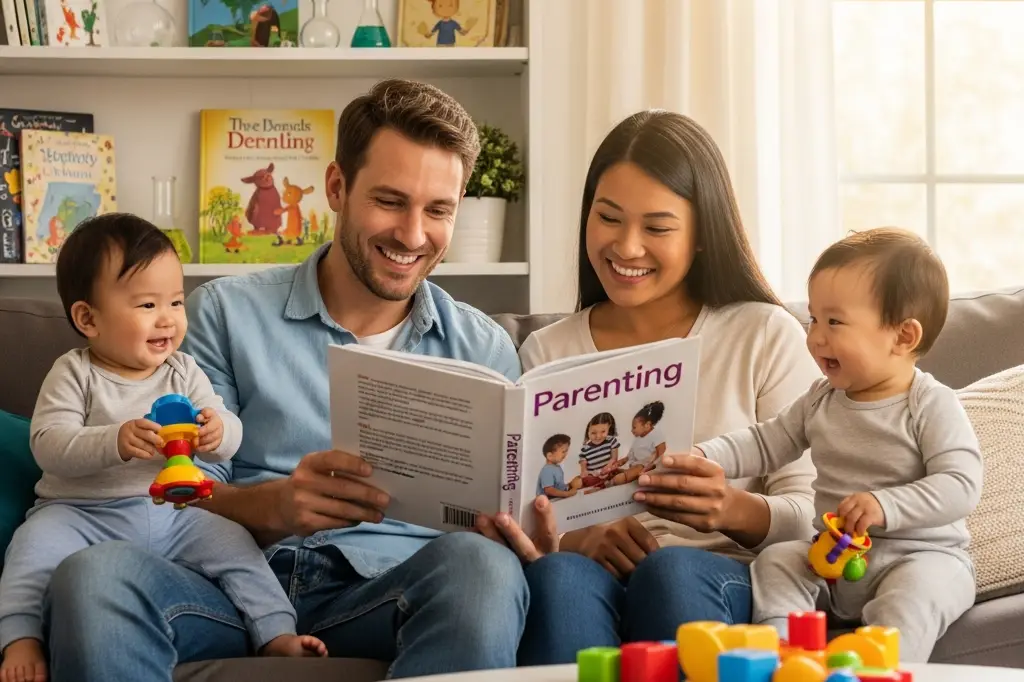Have you ever heard your twins having a full conversation in a language only they understand? This fascinating phenomenon is called twin talk, or cryptophasia. It is a captivating and completely normal part of twin development for many children. This article will guide you through the science behind this private language. You will learn what causes it and how it develops in early childhood. We will also explore its connection to speech delays with evidence-based facts. Finally, you will get practical strategies to nurture your twins’ communication skills. Understanding twin talk helps you support their amazing bond and their growth.
What is Cryptophasia? More Than Just Baby Talk
Cryptophasia describes a unique private language invented by twins. This phenomenon goes far beyond the simple mispronunciations of a single child. It is a complex system of communication shared only between them.
These private languages often include completely invented words. They also feature unusual grammar rules and sound substitutions. The twins understand each other perfectly, even if no one else can.
First, it is crucial to distinguish cryptophasia from idioglossia. While often used interchangeably, idioglossia means a “private speech” created by any individuals. Cryptophasia specifically refers to this phenomenon occurring between twins.
Next, understand that this language serves a real purpose. It allows the twins to communicate effectively within their own world. This bond is so intense it creates a closed communication loop between them.
Finally, this language is a natural byproduct of their unique relationship. Twins are each other’s first and most constant companions. Their private language is a testament to the powerful, self-contained world they build together from birth.
For parents, the key takeaway is simple. This private language demonstrates the incredible strength of the twin bond. It is a fascinating stage of development that deserves both appreciation and mindful guidance.
How Does Twin Talk Develop? The Perfect Social Storm
Twin talk does not have one single cause. It emerges from a perfect combination of social and linguistic factors. These elements are uniquely powerful in the lives of young twins.
The Mirror Effect: Constant Companionship
From birth, twins have a built-in mirror for development. They practice sounds and gestures with each other constantly. This intense parallel learning reinforces their linguistic experiments.
Unlike singletons who mostly hear fluent adults, twins get equal input from a peer. This creates a closed communication loop. Their own immature speech patterns are reflected and solidified between them.
The “Good Enough” Theory
Often, their invented language works perfectly for their needs. If one twin says “goba” for blanket and the other understands, communication succeeds. There is less pressure to use perfect words.
This efficient system can reduce motivation for adult speech. Their private language serves its purpose within the duo. It allows them to function before mastering standard language.
Divided Adult Attention
Parents of twins naturally divide their time and attention. This means less one-on-one language interaction for each child. Reduced adult modeling can slow standard language acquisition.
However, this doesn’t mean parents are doing anything wrong. It simply reflects the reality of caring for two children simultaneously. The twins fill this gap by communicating with each other.
Reinforced Errors and Invented Rules
In a singleton, speech errors are gently corrected by adults. In twins, these errors are often repeated and reinforced by their sibling. A mispronounced word can become standard in their private vocabulary.
They also create grammatical rules that work for them. These might include dropping pronouns or using special word order. The rules make sense within their private world but differ from conventional language.
The development of twin talk is a natural process. It shows how creatively children adapt to their social environment. Understanding these causes helps parents respond supportively rather than with concern.
What Does Twin Talk Sound Like? Decoding the Phenomena
Recognizing the features of twin talk helps parents understand what they’re hearing. This private language has several distinct characteristics that set it apart from typical baby talk.
Invented Vocabulary and Word Substitution
First, you will likely hear completely original words. These are not simple mispronunciations but true inventions. For example, twins might use “lolo” for a favorite toy or “bibi” for a blanket.
They also commonly substitute easier sounds for harder ones. A “k” sound might become “t,” making “cat” sound like “tat.” These substitutions are consistent between the twins, creating their own linguistic rules.
Unique Grammar and Sentence Structure
Next, their grammar often follows unusual, invented patterns. They might consistently drop pronouns, saying “Want cookie” instead of “I want a cookie.” Word order can be rearranged in ways that make sense only to them.
Their sentences might be telegraphic, using only the most essential words. This stripped-down structure is efficient for their private communication. The rules are logical within their closed system but differ from conventional language.
Sound Patterns and Rhythm
Finally, the rhythm of their conversation is a key clue. The flow often mimics adult speech patterns, complete with rising and falling intonation. This makes their twin talk sound like a real, foreign language to listeners.
You might notice extensive use of repetition and reduplication. Words like “wa-wa” for water or “ba-ba” for bottle are common. These rhythmic patterns are easy for them to produce and remember.
Understanding these features helps demystify twin talk. The patterns show sophisticated language adaptation, not just random babbling. This knowledge lets you appreciate the creativity behind their communication system.
The Great Debate: Is Twin Talk a Sign of Speech Delay?
This is the central question for many parents who observe twin talk. The relationship between this private language and speech development is complex. Understanding the evidence is key to making informed decisions.
The Evidence: What the Research Shows
Studies confirm twins are at a higher risk for speech delays. However, research does not prove twin talk itself causes the delay. Instead, both can be symptoms of shared underlying factors.
The most significant factor is often divided parental attention. Each twin naturally receives less one-on-one language interaction. This can slow the acquisition of standard grammar and vocabulary.
Other common factors include a higher rate of premature birth. There is also the factor of reinforced immature speech patterns between the twins. The private language is often a red flag, not the root cause.
When It’s a Normal Phase
Twin talk is usually a normal, passing phase if it coexists with other development. Look for a growing vocabulary of real, recognizable words. They should also be attempting to communicate with other family members.
This phase typically peaks between ages two and three. It often diminishes as twins spend more time in preschool. Increased social exposure encourages use of conventional language.
The key indicator is their ability to communicate with people outside their twin pair. If they can make their needs known to you, their twin talk is likely just a supplement.
When to Consider Seeking Help
Consult a pediatrician or speech-language pathologist if you notice certain signs. Be concerned if by age two, your twins use fewer than 50 recognizable words. Also note if they don’t combine two words like “my toy” or “more milk.”
Other red flags include difficulty following simple commands. Parents and regular caregivers should understand less than 50% of their speech by age three. Persistent frustration when communicating with outsiders is another warning sign.
Trust your instincts as a parent. You know your children best. Early intervention is highly effective and can address concerns quickly.
The Role of Professional Evaluation
A speech-language pathologist can provide a proper assessment. They will evaluate each twin’s language skills individually. This determines if a true delay exists separate from their twin talk.
The evaluation often involves hearing tests first. It also assesses their understanding of language and their ability to express themselves. This comprehensive approach provides a clear picture of their development.
Professional guidance can offer peace of mind. It either confirms typical development or creates an early action plan. This support benefits both your twins and your entire family.
The presence of twin talk alone is not a diagnosis. It is one piece of your twins’ overall communication picture. Combining observation with professional insight provides the best path forward.
Nurturing Language: An Evidence-Based Guide for Parents
Navigating twin talk requires a balanced approach. Your goal is to encourage standard language without dismissing their special bond. These evidence-based strategies will help you support their communication development effectively.
Do’s: How to Engage and Expand Their Language
First, prioritize one-on-one time with each twin daily.
Even ten minutes of individual conversation makes a big difference. Use this time to read a book or talk about pictures. This provides crucial undivided adult language modeling.
Next, become a gentle commentator during play.
Narrate what you and your twins are doing. Use simple, clear sentences like “I am building a tall tower” or “You are pushing the blue car.” This exposes them to correct grammar and vocabulary in context.
Then, expand on their attempts at communication.
If a twin says “ba” for ball, respond with “Yes, that’s a big, red ball!” This acknowledges their effort and models the complete word. Avoid criticizing their invented words.
Also, sing songs and recite nursery rhymes together.
The rhythm and repetition in songs reinforce sound patterns. This builds phonological awareness, a key pre-reading skill. Make it fun with hand motions and silly voices.
Finally, encourage interactions with other children.
Playdates with singletons expose twins to different speech models. This motivates them to use conventional language to be understood. Supervise these interactions to ensure positive experiences.
Don’ts: What to Avoid to Support Healthy Development
First, avoid overcorrecting their private language.
Constantly saying “No, say it this way” can create frustration. It may make them hesitant to speak. Instead, model the correct word naturally in your response.
Next, do not pretend to understand their twin talk.
Gently say “Can you show me what you want?” if you don’t understand. This encourages them to find another way to communicate. It teaches important problem-solving skills.
Also, limit background noise like constant television.
This creates a noisy environment that makes it hard to distinguish speech sounds. Create quiet times for conversation and book reading. This helps them focus on language.
Then, try not to always let them speak for each other.
If one twin answers for the other, gently redirect. Say “Let’s see what your sister wants to tell me.” This encourages each child to use their own voice.
Finally, avoid excessive worry or comparison to singletons.
Twins often develop language differently but catch up in time. Focus on their individual progress rather than direct comparisons. Celebrate their unique communication journey.
Your supportive approach makes a significant difference. Combining these strategies creates a rich language environment. You can honor their unique twin talk while guiding them toward effective communication with the wider world.
Beyond Childhood: Does Twin Talk Have a Long-Term Impact?
For most twins, twin talk is a temporary phase with no lasting effects. As they enter school and broaden their social circles, it naturally fades. The drive to communicate with teachers and friends encourages standard language use.
However, the underlying bond it represents is permanent. The deep, intuitive connection forged in early childhood remains. Twins often report understanding each other’s thoughts and feelings with minimal words. This lifelong bond is the true legacy of their early private language.
In rare cases where twin talk persists, it may indicate an underlying issue. This could include social anxiety or a significant speech disorder. Professional guidance can help address these concerns at any age.
Ultimately, the impact is what you make of it. With supportive parenting, this phase passes smoothly. It becomes a charming story about their childhood rather than a linguistic hurdle.
Conclusion: Celebrating the Bond, Nurturing Their Voice
Twin talk is a fascinating window into the unique world of twins. It demonstrates their incredible bond and creative problem-solving. Your role is to guide this creativity toward effective communication.
Celebrate their special connection while gently expanding their language skills. Provide rich language experiences and individual attention. Trust your instincts and seek professional advice if you have concerns.
Remember that this phase is typically short-lived. Your supportive approach ensures they develop strong communication skills. They will carry these skills forward while maintaining their special connection.
Want to explore more about twin development? Read about their emotional world in our article Twin Bond: Science & Stories of Emotional Connection. For more on speech milestones, the American Speech-Language-Hearing Association (ASHA) offers excellent resources for parents.


